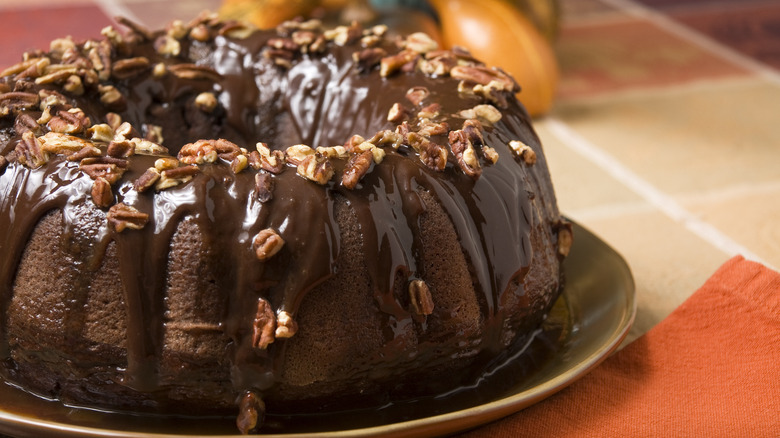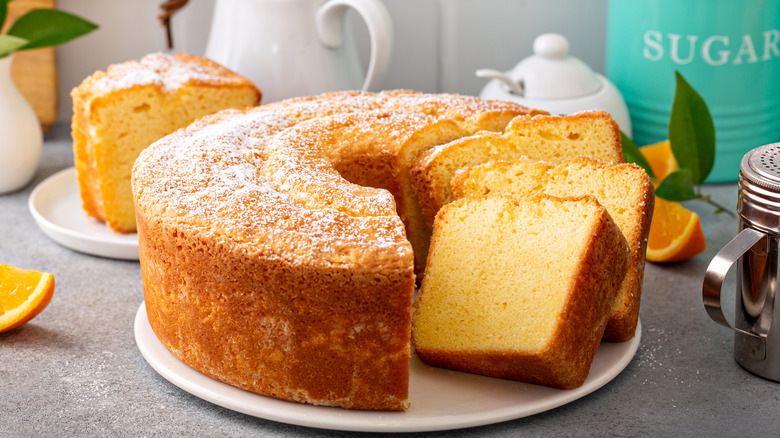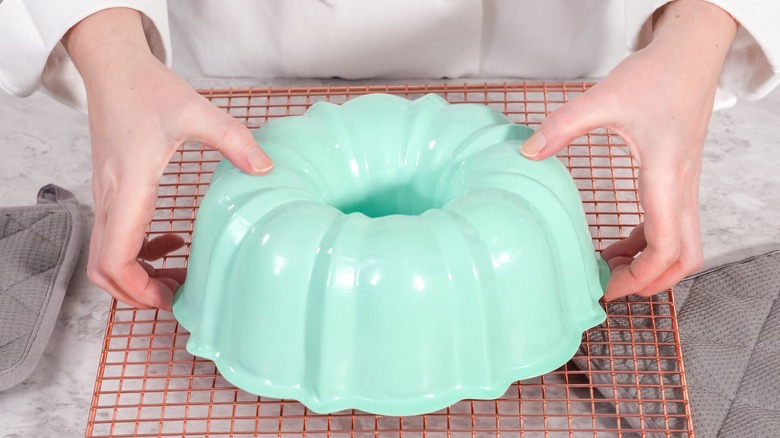The Scientific Reason Bundt Pans Are Perfect For Thick Cake Batter
Invented in 1950, the Bundt pan has cemented itself as a baker's favorite with its distinctive shape and look. With a variety of fluted patterns to choose from, even a beginner baker can make a visually appealing cake — no precision frosting required. But aesthetics alone aren't the reason why Bundt pans became one of the most popular ways of baking dense cakes like pound cake, chocolate cake, banana bread, and more. Notably, a Bundt pan offers a scientific advantage when it comes to baking thick cake batter: Its shape allows for even heat distribution around the cake and prevents gummy and heavy centers.
By virtue of thermodynamics and oven design, the exterior of a cake always bakes faster than the interior, and this is something you have to keep in mind. However, a thick batter exacerbates the issue because heat takes significantly longer to permeate the much denser liquid. When using a conventional cake pan for thick cakes, there's a well-insulated center pocket that will most likely cook at a much slower pace, often resulting in an uneven texture or even an undercooked middle.
A Bundt pan bypasses this issue via the central tube that separates the cake into a ring. It allows hot air to circulate evenly around the batter, ensuring that heat reaches the middle parts of the cake at the same rate as the outer rim.
How Bundt pans differ from tube pans
With all that said, you might be asking yourself: If the center tube is what makes a Bundt pan great for thick cake batter, how is it different from a tube pan? Since it also has a center tube, a tube pan would theoretically be equally good at circumventing gummy middles — and they are. You'll find that making pound cake in tube pans is far from unheard of.
However, the difference in shape between the two pans is why Bundt pans are excellent for thick cakes and absolutely terrible for lighter cakes. The fluted patterns may be perfect for thick crumb cakes that can hold their shape, but lighter cakes like angel food cake are more likely to get stuck in the crevices and destroyed before they can even be eased out of the pan. Furthermore, the round edges of a Bundt cake create a much more consistent distance from the hot metal to the most insulated part of the batter throughout, guaranteeing a more even bake. The fluted patterns also give more surface area for the fats of the batter to caramelize across — if you bake a heavier batter in a tube pan, you might end up with something a little greasy along the surface instead of nicely browned.
Other things they're excellent for
The greatest part about Bundt pans is that the thermodynamic logic behind why they're great for thick cakes makes them perfect for other kinds of dense food that heat up much slower in the middle. Branching out from various cakes and other baked goods, you'll find that a Bundt pan works just as well for getting an even cook on a dense meatloaf, ensuring a juicy inside without dry edges. It's also your perfect secret weapon for the crispiest chicken roast: Just prop the chicken up with the pan tube in the middle, then pack the rest of the pan with potatoes and other vegetables to soak up the chicken fat as it roasts.
It doesn't even have to be something that goes in the oven. The shape of a Bundt pan makes it an excellent mold for Jello cakes as well, as it helps the Jello set more consistently and prevents a watery middle. Don't be afraid to get creative with your Bundt pan either — you might find that it's one of the most versatile and useful tools in your kitchen.


